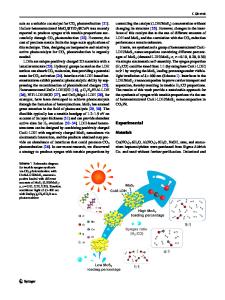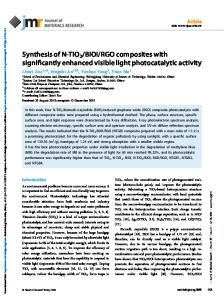Bi 12 TiO 20 nanocrystals prepared by electrochemical synthesis exhibit excellent photocatalytic ability under visible l
- PDF / 174,790 Bytes
- 1 Pages / 585 x 783 pts Page_size
- 44 Downloads / 262 Views
Bi12TiO20 nanocrystals prepared by electrochemical synthesis exhibit excellent photocatalytic ability under visible light
A
lthough titania (TiO2) is a good photocatalyst, its use is limited to the ultraviolet range and thus cannot be used in the visible solar light range. Bi12TiO20 has emerged in recent years as a promising alternative that may be used in the visible range. However, current methods to synthesize Bi12TiO20 are not well-suited to prepare ultrafine, well-dispersed, crystalline nanoparticles that are desired for photocatalytic applications. Recent work from the China Building Materials Academy in Beijing has resulted in a new electrochemical route to prepare well-dispersed Bi12TiO20 nanocrystals.
Numerical simulations predict ultrasmall subwavelength plasmonic cavity
P
lasmonic lasers (also called nanolasers), proposed about a decade ago, as well as other high-performance photonic devices, such as single-photon devices, require ultrasmall cavities. In contrast to diffraction-limited dielectric cavities, plasmonic cavities have resonant modes with subwavelength mode volumes. Although plasmonic lasing has been demonstrated, further modevolume reduction is required for the high density integration of plasmonic devices. Toward this goal, S.-H. Kwon of ChungAng University in South Korea along with H.-G. Park and co-researchers at Korea University have proposed a novel plasmonic cavity and used numerical simulations to demonstrate mode vol-
480
MRS BULLETIN
•
VOLUME 36 • JULY 2011
•
enables it to operate at voltages compatible with hand-held electronics. Together with the fact that they can be easily microfabricated in wafer-sized arrays, these
liquid lenses have considerable potential for use in commercial devices, according to the researchers. Tobias Lockwood
Current solid-state synthesis and wet chemical methods used to prepare Bi12TiO20 require high temperature processing or special equipment that yield large-sized aggregated crystals which are at best sub-optimal for photocatalytic applications. Reporting in the May issue of the Journal of the American Ceramic Society (DOI: 10.1111/j.15512916.2011.04505.x; p. 1336), C. Gao, J. Ma, and co-workers prepared Bi12TiO20 nanoparticles by precipitation in an electrolytic solution using Bi and Ti plates as the anode and cathode, respectively. Adjusting the concentration of H3PO4 in the electrolyte caused a change in nanoparticle dispersion. Electron microscopy revealed that a pure body-centered cubic (bcc) phase was formed in the absence of H3PO4 where the nanoparticles agglomerate into 2–3 μm spheres. However, increas-
ing the concentration of H3PO4 increased the fraction of the face-centered cubic (fcc) phase with a concomitant weakening of the interparticle adhesion resulting in a well-dispersed Bi12TiO20 nanoparticle mixture of bcc and fcc phases. UV-vis absorption spectra of the prepared samples revealed absorption onset wavelengths exceeding 500 nm, exhibiting good response in the visible light region. The Bi12TiO20 particles also efficientl
Data Loading...











